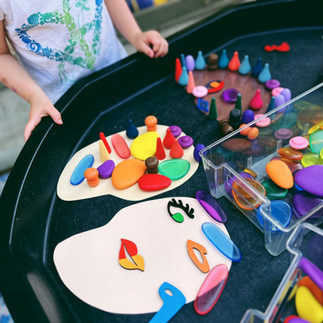Pablo Picasso Still Life Paintings & Loose Parts Play
- Yasmeen Kamrani Sallam

- Aug 27, 2023
- 2 min read
Pablo Picasso Still Life Paintings & Loose Parts Play// Pablo Picasso is the Artist of the Month. We have been reading so many wonderful books to learn about the Spanish Artist who changed art forever while exploring all the ways he created art.

Today we set out two different invitations inspired by his art.

1. Invitation to Still Life Paint "Mains aux Fleurs": This painting was also known as the Bouquet of Peace, Hands with Flowers, Bouquet of Flowers. Since Picasso was renowned for his style and diversity of art he chose to keep this painting simple. The painting consists of two hands holding flower stalks.

We set this invitation with mannequins hands holding a bouquet of flowers and the image of his artwork as the point of inspiration. Tempera paint, brushes, and paper were provided. The children were invited to do a still life painting.
Inviting children to do a still life is a drawing or a painting of an object or a group of objects is a wonderful way for the children to observe every detail in the objects, compare similarities/differences, & become more aware of details. These types of invitations to paint are amazing because it's interesting to observe each child's individual approach and creativity blossom. 2. Invitation to Create Cubism Self Portraits with Loose Parts: Picasso, is considered to be one of the pioneers of Cubism, a daring artistic movement from 1904 through the early 1920s. Cubism is often cited as the most influential art movement of the 20th century, inspiring many future modern artists, as well as other artistic fields, like architecture. In his portraits he mixed up all the features in faces and they turned out to look like 'funny faces'.

We set this invitation with images of his Cubist Portraits. Provided abstract faces and loose parts. The children were invited to create their own renditions of Pablo Picasso Portraits.

When a child uses loose parts to create, it gives opportunities to work on spatial awareness, exposes them to different forms of art, paying attention to detail, and enhancing their language skills as they communicate what they see or what they are doing. As they manipulate the loose parts to fit inside, outside, or around the designs they are enhancing their fine motor skills, hand-eye coordination, and shape recognition. Loose parts are dynamic by nature, therefore the child is given the opportunity to be just as creative as Pablo Picasso.



























































Comments